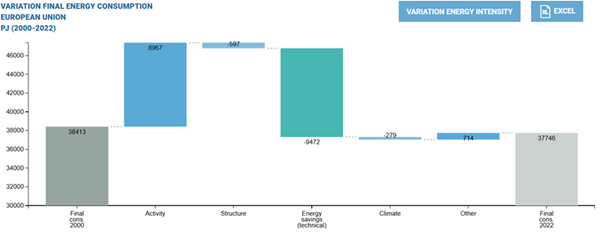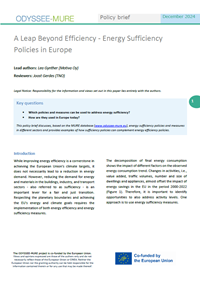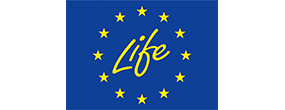Summary
Key questions
- Which policies and measures can be used to address energy sufficiency?
- How are they used in Europe today?
Lead authors: Lea Gynther (Motiva Oy)
Reviewers: Joost Gerdes (TNO)
Introduction
While improving energy efficiency is a cornerstone in achieving the European Union's climate targets, it does not necessarily lead to a reduction in energy demand. However, reducing the demand for energy and materials in the buildings, industry, and transport sectors - also referred to as sufficiency - is an important lever for a fair and just transition. Respecting the planetary boundaries and achieving the EU's energy and climate goals requires the implementation of both energy efficiency and energy sufficiency measures.
The decomposition of final energy consumption shows the impact of different factors on the observed energy consumption trend. Changes in activities, i.e., value added, traffic volumes, number and size of dwellings and appliances, almost offset the impact of energy savings in the EU in the period 2000-2022 (Figure 1). Therefore, it is important to identify opportunities to also address activity levels. One approach is to use energy sufficiency measures.
Figure 1: Decomposition Results in the EU

Source: Odyssee Database, sourced on 26 November 2024
Energy Sufficiency Policy Types
The concept of energy sufficiency is still not understood in similar ways by everyone. Therefore, one of the starting points in the Odyssee-Mure project was to make an inventory of the different definitions and to formulate terminology, which both allowed development of the database structure and facilitates further analysis of energy sufficiency. Definitions were formulated for energy sufficiency, energy sufficiency actions, and energy services, as well as the clarification of the difference between energy sufficiency and energy efficiency:
- Energy sufficiency: A state in which people’s basic needs for energy services are met equitably and ecological limits are respected.
- Energy sufficiency actions: Actions which reduce energy demand to take us towards the energy sufficiency state, whilst at the same time changing the quantity or quality of the energy services demanded in a sustainable way and not below people’s basic needs.
- Energy services: The benefits provided by energy, such as cooking, lighting, cooling, IT-based communication, automotive transport, and industrial processes.
- Sufficiency vs. efficiency: The nature of changing the quantity or quality of the energy services demanded is exactly what distinguishes energy sufficiency actions from energy efficiency actions.
In mid-October 2024, the MURE database1 contained 96 policies and measures addressing energy sufficiency. They have been reported by twenty countries, of which three are Energy Community countries.
Sufficiency measures are categorised by three different action types, namely avoiding or ceasing, substitution, and adjustment of energy services (Table 1). They are also categorised by sufficiency impact mechanisms into direct sufficiency measures and indirect monetary and non-monetary measures (Table 2).
Table 1: Type of Action
| Avoiding/Ceasing | Substitution | Adjustment | |
| Cross-cutting | 10 | 13 | 24 |
| Transport | 11 | 26 | 12 |
| Households | 3 | 2 | 10 |
Source: MURE database, sourced on 15 October 2024
Table 2: Measures by Type of Impact on Energy Services
| Direct | Indirect - monetary | Indirect – non-monetary | |
| Cross-cutting | 3 | 2 | 7 |
| Transport | 3 | 7 | 20 |
| Households | 3 | 2 | 1 |
Source: MURE database, sourced on 15 October 2024
Note: Table totals differ from the total number of measures. In Table 1, multiple options may apply for a single measure and full information may not have been reported by national project teams for Table 2.
The role of Energy Sufficiency in the Energy Crisis of 2022-2023
The energy crisis, with supply risks and extremely high energy prices in the heating season 2022-2023, prompted most European countries to introduce emergency measures to address risks of imminent gas and power shortages and to alleviate the impacts of surging energy prices. Many of these measures aimed at demand reduction rather than merely at energy efficiency. They prompted public bodies, companies, and citizens to consider what constitutes a sufficient level of energy services.
Mandatory measures were introduced to cap indoor temperatures, while information was disseminated through various media to address behavioural aspects. The MURE database includes multiple examples of such measures, e.g., Flip the Switch Campaign in the Netherlands, Operation Thermostat in the public sector in Greece, sufficiency measures in the public sector in Latvia, and the Down a Degree Campaign in Finland.
These measures proved effective as they clearly helped Europe to get through the winter of crisis. However, thorough evaluation results are not available for all measures and, apart from mandatory measures, the long-term impact may be limited.
Energy Sufficiency Policies in the Household Sector
For the household sector, twelve sufficiency measures were reported by eleven countries.
In Malta, the Electricity Tariff Structure & Eco-Reduction measure established an electricity pricing methodology whereby the unit cost for electricity increases along with the consumption level.
An example of a regulatory approach can be found in France, where temperature limits for heating and cooling buildings were already established in the 70’s.
In Slovenia, it was observed that allocating and billing heating costs based on actual consumption in multi-apartment buildings reduced heat consumption by 5%.
Energy Sufficiency Policies in the Transport Sector
Forty-two sufficiency measures aimed at the transport sector were reported by thirteen countries.
In addition to comprising more sufficiency measures than other sectors, there is also large variety in the ways the measures work, both in terms of type of action and type of impact. Fuel taxes and city tolls reduce mileage. Progressive CO2 taxation and bonus-malus systems affect the demand for vehicles of different sizes. Subsidies, infrastructure development, promotional measures, and shared economy platforms increase the appeal of public transport, walking, and cycling compared to private cars.
France simultaneously subsidises low-emission cars and imposes taxes on high-emission and heavy vehicles (bonus-malus scheme). Finland introduced emission-dependent car purchase taxation in 2008 and Greece implemented a similar measure in 2010. While emission-based taxation may not moderate the size of cars anymore since electric vehicles are becoming more common, it at least had an interim impact.
Germany encourages a shift from air transport to rail transport by posing a levy on the former and by reducing value added tax for the latter.
Better infrastructure encourages the use of public and light transport. Latvia promotes the development of bicycle and micromobility infrastructure and Slovenia continues to improve cycling infrastructure. Bulgaria has expanded the subway network in Sofia. In Spain, local entities get aid for investments in cycling infrastructure.
France supports the procurement of electric bikes for seniors with low income. Finland supports commuting by public transport and electric bikes by reducing the taxable income values of fringe benefits provided by the employer.
Through the Alternative Travel Approach, companies and the Dutch government have pledged to reduce travel-related greenhouse gas emissions by 50% from 2016 to 2030 using various tools. These include increased travel-cost reimbursement for cycling to work, issue of a public-transport card, and restrictions on (free) parking at the workplace.
Energy Sufficiency Policies in the Services Sector
Fourteen sufficiency measures aimed at the services sector were reported by nine countries. Two examples are described below.
The Greek programme Operation Thermostat sets a guideline for public sector operators not to cool below 27 degrees Celsius in summer and not to heat above 19 degrees Celsius in winter. It also advocates, among other things, the installation of window shields in public buildings, deactivation of air conditioning equipment in areas and at times when there are no employees, equpment maintenance, and use of night ventilation.
In Finland, a 2021 government decision of principle sets a target for 2030 to reduce office space per state employee from an average of 18 m2 to 10 m2. This takes into account increased hybrid and teleworking. Governmental offices were to update their plans for using space by the end of 2022 to accommodate the new target. Earlier space reduction targets were set in 2005 and 2014.
Cross-cutting Energy Sufficiency Policies
Twelve countries reported a total of twenty-six cross-cutting sufficiency measures.
In 2022, the French government launched an Energy Sufficiency Plan addressing all sectors to alleviate the effect of the energy crisis and to prevent potential power outages during the winter period. The plan was recast in 2023 to include long-term objectives. Similarly, Spain launched Plan +SE (More Energy Security Plan) in 2022 comprising 73 measures, some also addressing energy sufficiency, in different sectors to improve crisis readiness.
A commonly used policy for both energy efficiency and sufficiency is energy taxation. Taxes increase energy prices and ensure consumers both consider their energy use patterns, including what is sufficient, and invest in energy efficiency measures.
Integrating Energy Sufficiency into the Energy Efficiency Scoreboard Tool of Odyssee-Mure
The Energy Efficiency Scoreboard tool on the Odyssee-Mure website ranks countries based on their performance both for the country as a whole and per sector. This is done by using a combined score of energy efficiency levels (Odyssee indicators), energy efficiency improvement trends (Odyssee indicators), and expected impact of energy efficiency policies by 2030 (Mure data). All three are weighted equally in the overall scores.
The next development phase of the scoreboard will involve the inclusion of energy sufficiency. In the energy efficiency levels and trends modules, this requires determination of the impact of increased comfort levels on the indicators. This will be done by analysing the percentage increase in sectoral energy demand over a given period from decomposition. In the policy impact module, this involves separating the impact of sufficiency from the total observed policy impact.
Discussion
The recently revised Energy Efficiency Directive and Building Energy Performance Directive do not take a position on energy sufficiency, as they concentrate solely on energy efficiency. At the same time there is increasing interest in sufficiency within civil society. For example, a couple of years ago French citizens voted for sufficiency as their first recommendation in the convention on the future of the EU.
The growing interest is also reflected by the 2024 Sufficiency Manifesto, signed by over 70 European organisations. It calls for European sufficiency strategy, along with binding targets for the reduction of energy and material consumption.
While many energy efficiency policies and measures promote energy sufficiency as well, the Sufficiency Manifesto is also worth attention in its own right. Its value was demonstrated during the 2022-2023 energy crisis, but structural longer-term sufficiency policies are needed. Energy consumption does not decrease enough with just energy efficiency and there are numerous environmental, economic, and energy security benefits associated with lower consumption.
Notes
- 1: Sufficiency measures can be accessed in database search under More Options – Measure Characterisation – Energy poverty & sufficiency






